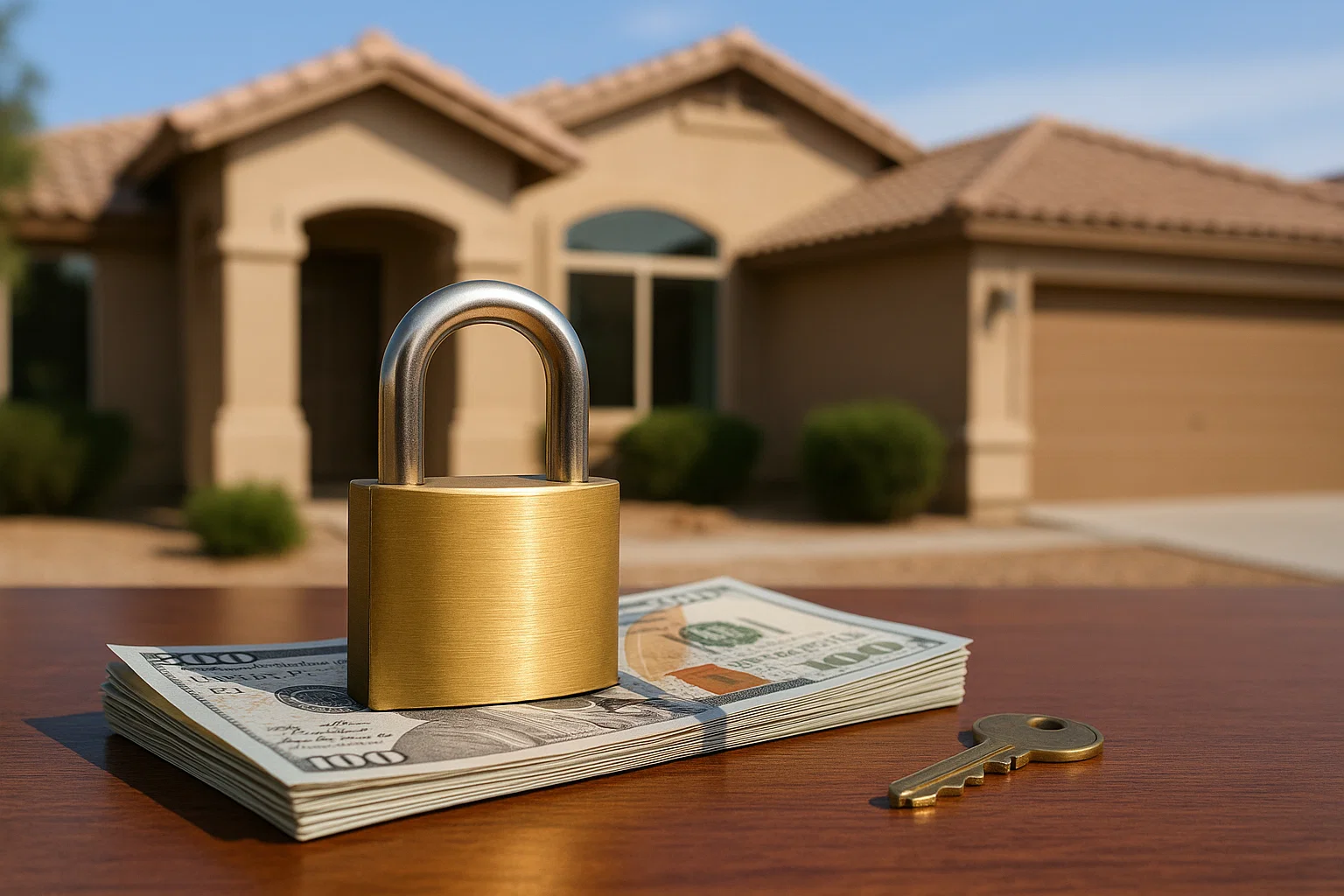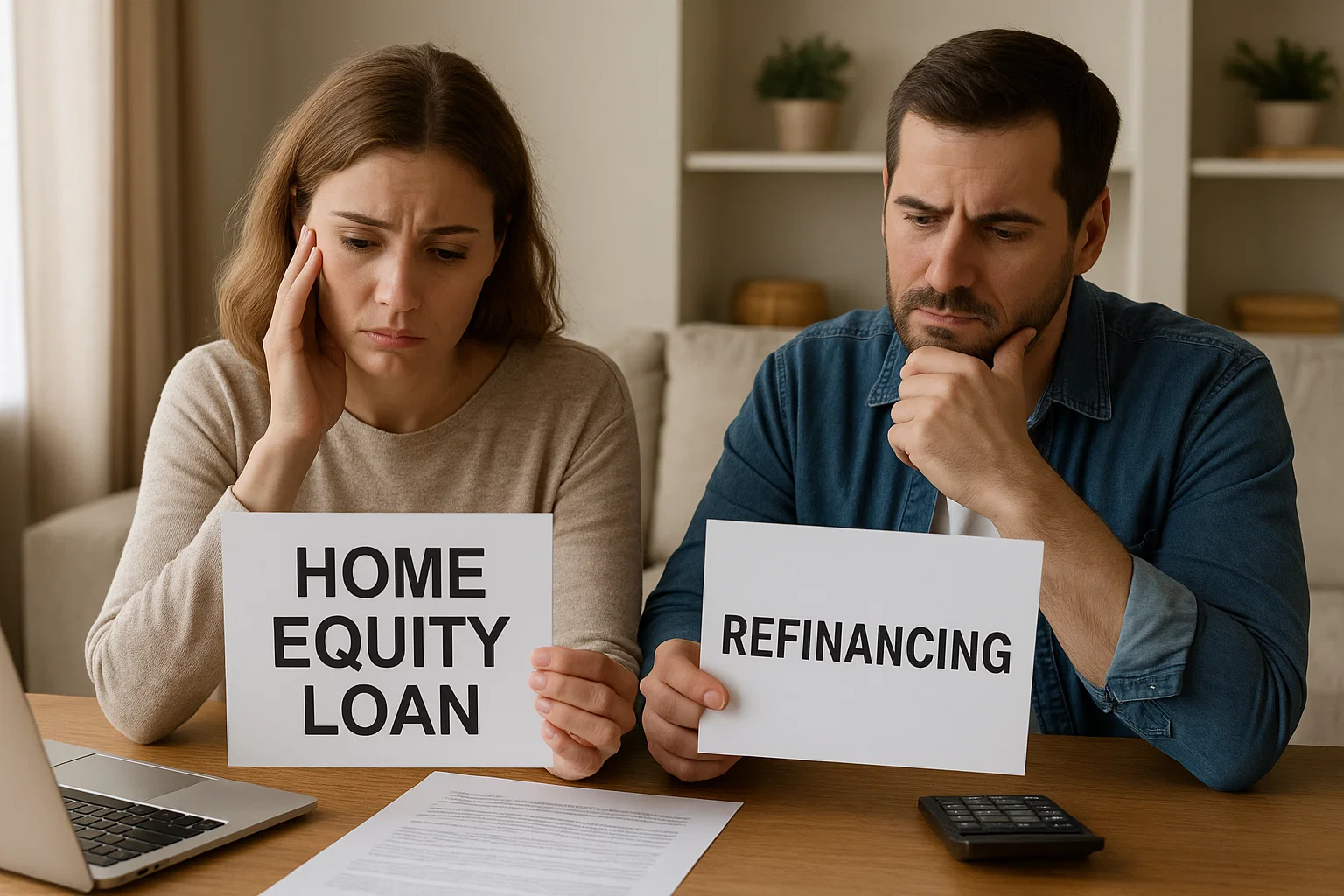Smart Strategies for Refinancing Your Home Equity Loan in 2025
November 19, 2025
Learn smart strategies to refinance your home equity loan in 2025. Explore options, process, and financial impact for your home equity loan.

Thinking about your home equity loan in 2025? Maybe you want to do some work around the house, pay off some nagging debts, or just have a bit of a cushion for whatever life throws your way. Refinancing your home equity loan could be a good move, but it's not something to jump into without a plan. Let's look at some smart ways to approach refinancing your home equity loan to make sure it works for you.
Key Takeaways
- Understand if a home equity loan (lump sum, fixed rate) or a HELOC (flexible, variable rate) fits your needs better when you refinance.
- Consider refinancing to lower interest rates, consolidate high-interest debt, or fund necessary home improvements that add value.
- Be ready to show lenders your income, credit history, and how much equity you have in your home (your Loan-to-Value ratio is important).
- Shop around with different lenders – banks, credit unions, and others – as they all have different rates and rules for a refinance.
- Always calculate potential savings against any fees and penalties to find your break-even point before you refinance your home equity loan.
Understanding Your Home Equity Loan Options

So, you're thinking about tapping into your home's equity in 2025? That's smart. Your home equity is basically the difference between what your house is worth and what you still owe on your mortgage. It's a chunk of money you've built up over time, and there are a couple of main ways to access it.
Home Equity Loan Versus HELOC
When you decide to borrow against your home's equity, you'll usually run into two primary options: a home equity loan and a Home Equity Line of Credit (HELOC). They sound similar, but they work quite differently, and knowing the difference is key to picking the right one for your situation.
- Home Equity Loan: Think of this like a traditional loan. You get a lump sum of cash all at once, and then you pay it back over a set period with fixed monthly payments. The interest rate is usually fixed too, which makes budgeting easier. This is often a good choice if you have a specific, large expense in mind, like a major home renovation or a big debt to pay off.
- HELOC: This is more like a credit card secured by your home. You get approved for a certain credit limit, and you can borrow money as you need it, up to that limit. You only pay interest on the amount you actually use. The interest rates on HELOCs are typically variable, meaning they can go up or down over time. This flexibility makes HELOCs great for ongoing expenses or when you're not sure exactly how much you'll need.
Here’s a quick rundown:
When a Second Mortgage Is a Viable Choice
Sometimes, you might hear the term "second mortgage." This is often used interchangeably with a home equity loan, especially when it's a lump sum loan taken out in addition to your primary mortgage. It's a viable option if you can't refinance your first mortgage, perhaps due to credit issues or if you want to keep your current first mortgage's interest rate. It allows you to access your home's equity without touching your original loan. It's important to remember that borrowing against your home means your house is collateral, so you need a solid plan to repay the loan.
Borrowing against your home's equity is a significant financial decision. It's not free money, and it comes with risks. Always make sure you have a clear understanding of the terms, interest rates, and your ability to repay before you sign anything. Your home is on the line, after all.
Strategic Reasons to Refinance Your Home Equity Loan

So, you've got a home equity loan, and you're thinking about refinancing it. That's smart. It's not just about getting a new loan; it's about making your money work better for you. Let's look at some solid reasons why refinancing makes sense in 2025.
Consolidating High-Interest Debt
Got a pile of credit card bills or maybe a personal loan with a really high interest rate? It can feel like you're just treading water, paying a lot but not really getting ahead. Refinancing your home equity loan can be a game-changer here. You can take all that high-interest debt and roll it into your home equity loan. This usually means you get a lower interest rate, which saves you money over time. Plus, instead of juggling multiple payments, you've got just one, simpler payment to manage each month. It can really take a load off your mind and your wallet.
Funding Value-Adding Home Renovations
Thinking about finally tackling that kitchen remodel or maybe adding a new bathroom? Using your home equity for improvements that actually increase your home's value is a smart move. Refinancing can give you the lump sum you need for these projects. It's generally better to borrow for things that make your home more valuable or functional, rather than just for everyday stuff. Just be sure to plan your project budget carefully so you don't end up borrowing more than you need or can comfortably repay. This can be a great way to improve your living situation and potentially boost your home's resale value down the road.
Accessing Funds for Unexpected Expenses
Life happens, right? Sometimes, unexpected things pop up – maybe your car breaks down, or you have a medical emergency. Having access to funds can prevent a small problem from turning into a big financial headache. Refinancing your home equity loan can provide that financial cushion. It's about having a plan for those 'what if' moments. Having a readily available source of funds can provide peace of mind and prevent you from taking on high-interest debt in a pinch.
Borrowing against your home equity should always be part of a larger financial plan. It's easy to get excited about the funds available, but it's critical to have a clear repayment strategy in place before you borrow. Think about how this new loan fits into your overall budget and long-term financial goals. Making sure you can comfortably manage the payments is key to avoiding future stress.
Navigating the Refinancing Process in 2025
So, you're thinking about refinancing your home equity loan. It sounds like a good idea, right? Maybe you want a lower monthly payment, or perhaps you need to tap into that equity for something important. Whatever your reason, getting through the refinancing process smoothly is key. It's not just about finding a new loan; it's about making sure it actually helps your financial situation.
Key Qualification Factors Lenders Consider
Before you even start looking at lenders, you need to know if you even qualify. Lenders aren't just handing out money willy-nilly. They want to see that you're a safe bet. This means having a solid credit history and a steady income are super important. They'll look at your credit score, your debt-to-income ratio, and your employment history. Basically, they want to be sure you can handle another loan payment without breaking a sweat. It's also about how much equity you have left in your home. If you've already borrowed a lot, it might be harder to get approved for more. You can check your credit report for free to see where you stand.
Understanding Loan-to-Value Ratios
This is a big one. The loan-to-value (LTV) ratio compares how much you owe on your mortgage and any other loans secured by your home to the actual market value of your house. Lenders use this to figure out how much risk they're taking. A lower LTV generally means you have more equity and are a lower risk. For example, if your home is worth $500,000 and you owe $300,000 on your mortgage and home equity loan combined, your LTV is 60% ($300,000 / $500,000). Most lenders prefer an LTV of 80% or less for refinances, though this can vary.
Here's a quick look at how LTV affects things:
- Low LTV (e.g., below 70%): You likely have good equity, making you a strong candidate for refinancing with favorable terms.
- Medium LTV (e.g., 70%-80%): You might still qualify, but the rates or terms could be less attractive.
- High LTV (e.g., above 80%): Refinancing can be challenging, and you might face higher interest rates or stricter requirements.
Preparing Necessary Documentation
Getting your paperwork in order is probably the least fun part, but it's absolutely necessary. Think of it like gathering all your ingredients before you start cooking. You'll need proof of income, like recent pay stubs and tax returns. Lenders will also want to see your current mortgage statements and details about any other debts you have. A fresh appraisal of your home might be required, and they'll definitely pull your credit report. Having all this ready to go can speed up the whole process considerably. It shows you're serious and organized.
Refinancing involves costs like appraisal fees, legal charges, and lender fees. It's important to calculate how long it will take for your monthly savings to cover these initial expenses. If this break-even point is longer than you plan to stay in your home, refinancing might not be the best move.
Evaluating Lender Types for Your Refinance
When you're looking to refinance your home equity loan, figuring out who to borrow from is a big step. It's not a one-size-fits-all situation, and different lenders have different strengths and weaknesses. Think of it like picking the right tool for a job – you wouldn't use a hammer to screw in a bolt, right? The same applies here. Your financial picture, how quickly you need the money, and your credit history all play a role in determining the best lender for you.
Comparing Banks, Credit Unions, and Alternative Lenders
Traditional banks are often the first place people think of, and for good reason. They tend to offer the most competitive interest rates, especially if you have a strong credit score and a solid financial history. However, they can also be the pickiest about who they lend to. If your credit isn't perfect or your income is a bit irregular, a bank might not be your best bet.
Credit unions are a bit different. They're member-owned, which often means they're more flexible and willing to work with borrowers who might not fit the strict mold of a big bank. They might offer slightly less competitive rates than the top banks, but their willingness to consider individual circumstances can be a huge advantage. Many homeowners find that credit unions provide a more personal touch. For example, Connexus Credit Union is known for its no-appraisal option, which can speed things up considerably.
Then you have alternative lenders, sometimes called B lenders. These guys are generally more open to borrowers with less-than-perfect credit or non-traditional income sources. The trade-off? You'll likely see higher interest rates and potentially more fees. They're a good option if you've been turned down by banks and credit unions, but it's important to do your homework to make sure the costs don't outweigh the benefits.
When Private Lenders Might Be the Best Fit
Private lenders operate a bit outside the traditional system. They often focus specifically on home equity products and can be incredibly flexible. This flexibility comes at a cost, though – typically higher interest rates than banks or credit unions. However, if you need funds quickly or have a unique financial situation, a private lender might be your only viable option. They often require less documentation and can process applications much faster. This speed and flexibility can be invaluable when facing unexpected expenses or time-sensitive projects.
Here's a quick look at what each type might offer:
- Banks: Best for borrowers with excellent credit and stable income. Usually offer the lowest rates.
- Credit Unions: Good for members looking for more personalized service and some flexibility. Rates are competitive.
- Alternative Lenders: Suitable for those with credit challenges or irregular income. Rates are higher.
- Private Lenders: Ideal for urgent needs or complex financial situations. Highest rates but most flexible.
Choosing the right lender involves weighing interest rates against qualification requirements and speed of funding. Don't just go with the first option you find; compare offers from several different types of lenders to find the best fit for your specific situation. It's worth taking the time to explore options like PNC Bank if you're looking for a top overall lender.
When considering your options, always ask about the total cost of the loan, not just the interest rate. This includes all fees, points, and potential penalties. Understanding these details will help you make a sound decision about refinancing your home equity loan.
Calculating the Financial Impact of Refinancing
So, you're thinking about refinancing your home equity loan. That's a big step, and it makes sense to figure out if it's actually going to save you money. It's not just about getting a new interest rate; there are other costs and benefits to consider. Let's break down how to look at the numbers.
Assessing Interest Rate Savings
The most obvious reason to refinance is to snag a lower interest rate. If the rates available now are significantly lower than what you're paying, you could be looking at some real savings over the life of your loan. It's worth checking what the current market rates are and comparing them to your existing loan. Even a small drop in percentage points can add up to a lot, especially if you have a large balance or a long time left on the loan.
Calculating Your Break-Even Point
This is super important. Refinancing isn't free. You'll have closing costs, which can include things like appraisal fees, title insurance, recording fees, and sometimes even a prepayment penalty on your old loan. You need to figure out how long it will take for the money you save each month on your new loan to cover these upfront costs. This is your break-even point.
Here's a simple way to think about it:
- Add up all your closing costs. This is the total amount you'll spend to get the new loan.
- Find your monthly savings. Subtract your new estimated monthly payment from your current one.
- Divide total costs by monthly savings. The result is the number of months it will take to recoup your expenses.
For example, if your closing costs are $4,000 and your new loan saves you $200 per month, it will take 20 months to break even ($4,000 / $200 = 20). If you plan to stay in your home and keep this loan for much longer than 20 months, then refinancing likely makes financial sense.
It's easy to get caught up in the idea of a lower monthly payment, but always do the math on the break-even point. If you plan to move or pay off the loan before you reach that point, you could end up spending more money overall.
Understanding Potential Fees and Penalties
Don't forget about the hidden costs. Besides the standard closing costs, check if your current loan has any prepayment penalties. Some loans charge you a fee if you pay them off early, which could eat into your savings. Also, consider if refinancing will change your loan term. If you extend your loan term to lower your monthly payment, you might end up paying more interest in the long run, even with a lower rate. It's a trade-off you need to be comfortable with.
Responsible Equity Use and Repayment Planning
Developing a Realistic Repayment Strategy
So, you've decided to tap into your home equity. That's great, but before you spend a dime, let's talk about how you're going to pay it back. It sounds obvious, right? But people get caught up in the excitement of having extra cash and forget this part. Having a solid repayment plan is non-negotiable. Think about your current income, any expected raises, or if you plan to refinance again down the line. It's not just about what you can borrow, but what you can comfortably manage over the loan's life. A little planning now can save a lot of headaches later.
Here’s a quick way to think about your repayment:
- Assess Your Cash Flow: Look at your monthly income versus your expenses. How much extra can you realistically put towards this new loan payment?
- Factor in Interest: Remember that interest adds up. Make sure your repayment plan accounts for the total cost, not just the principal.
- Consider Your Timeline: Are you aiming to pay it off quickly, or spread it out over the maximum term? This affects your monthly payment amount.
Borrowing against your home is a big step. It's easy to get focused on the immediate benefits, but the long-term implications are what really matter. Always ask yourself if this borrowing fits into your overall financial picture for years to come.
Avoiding Over-Borrowing for Lifestyle Purchases
It's tempting, isn't it? You see that big number you qualify for, and suddenly that dream vacation or a new car seems within reach. But here's the thing: using your home equity for things that don't add lasting value can be a risky move. Your home is likely your biggest asset, and you don't want to put it at risk for something that depreciates or is gone in a few weeks. Stick to borrowing what you truly need for investments like home improvements or debt consolidation. Remember, your home's value can fluctuate, so borrowing too much now might mean you owe more than it's worth later, especially if the market dips. It's generally smarter to use your equity for things that improve your home or financial standing, rather than just for everyday wants. Homeowners possess significant home equity but remain cautious about credit, and this trend is fueling a revival in Home Equity Lines of Credit (HELOCs) as people look for flexible borrowing options, but responsible use is key.
Considering Long-Term Financial Health
Refinancing your home equity loan isn't just about getting a better rate today; it's about setting yourself up for a healthier financial future. Think about how this loan fits into your bigger financial goals. Are you trying to pay down high-interest debt to free up cash flow? Are you investing in your home to increase its value and your net worth? These are generally good reasons. However, if the plan is just to fund a lifestyle that you can't currently afford, that's a different story. It's important to look at the total picture: your income, your other debts, your savings, and your long-term plans. Making smart choices now with your home equity can significantly impact your financial stability for years to come. Don't let short-term desires jeopardize your long-term security.
Wrapping It Up
So, looking at refinancing your home equity loan in 2025? It’s definitely something to think about, especially with how things are in the housing market right now. Whether you're trying to get a better rate, pay down some high-interest debt, or just get some cash for home improvements, having a solid plan is key. Don't forget to look at all the costs involved, like penalties and closing fees, and make sure the savings really add up over time. It’s not a decision to rush into, so take your time, do your homework, and maybe chat with a pro to make sure you’re making the best move for your finances.
Frequently Asked Questions
What exactly is home equity, and why should I care about it in 2025?
Think of home equity as the part of your home's value that you truly own. It's what's left over after you subtract what you still owe on your mortgage from your home's current worth. As you pay down your loan or your home becomes more valuable, your equity grows. In 2025, understanding your equity is key because it's like a piggy bank you can tap into for big needs, but you need to know how much is there before you can borrow.
Can I use money from my home equity to pay off my credit cards or other debts?
Absolutely! Many people use their home equity to pay off debts that have high interest rates, like credit cards or personal loans. This can make your monthly payments much simpler and often cheaper because the interest rate on a home equity loan is usually lower than on a credit card. It's a common way to get a handle on debt.
What's the difference between a home equity loan and a HELOC?
It's a bit like comparing a one-time cash gift to a flexible credit line. A home equity loan gives you a set amount of money all at once, and you pay it back in regular, fixed payments. A HELOC (Home Equity Line of Credit) is more like a credit card; you can borrow money as you need it, up to a certain limit, and you only pay interest on the amount you've actually used. HELOCs often have changing interest rates.
When is a good time to think about refinancing my home equity loan?
Refinancing can be a smart move if interest rates have dropped since you first got your loan, or if your financial situation has changed. It might also make sense if you want to change your payment schedule or if you need to access more funds. It's best to look into it when you see potential savings or when your needs change.
What kind of paperwork will I need to get a home equity loan?
Lenders will want to see proof of who you are and that you can pay the loan back. This usually includes things like your ID, recent pay stubs or tax returns to show your income, and statements for your current mortgage. They might also need an appraisal of your home to know its current value. Being organized with your documents can make the process go much smoother.
What happens if my home's value goes down after I borrow against my equity?
Home values can go up and down. If your home's value drops, the amount of equity you have decreases. This could mean that the loan amount you took out is now a larger percentage of your home's total value. While it doesn't usually mean you lose your home immediately, it could make it harder to borrow more in the future or affect your loan-to-value ratio, which lenders look at closely.













Get in touch with a loan officer
Our dedicated loan officers are here to guide you through every step of the home buying process, ensuring you find the perfect mortgage solution tailored to your needs.
Options
Exercising Options
Selling
Quarterly estimates
Loans
New home

Stay always updated on insightful articles and guides.
Every Monday, you'll get an article or a guide that will help you be more present, focused and productive in your work and personal life.









.png)
.png)
.png)
.png)
.png)
.png)
.png)
.png)
.png)
.png)
.png)
.png)
.png)
.png)
.png)
.png)
.png)
.png)